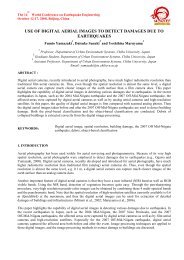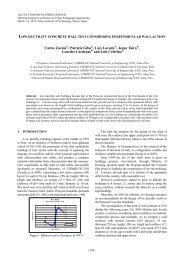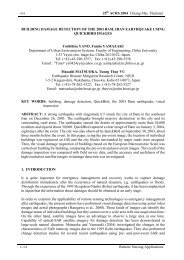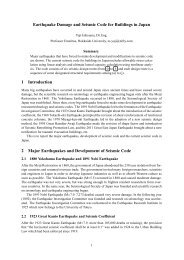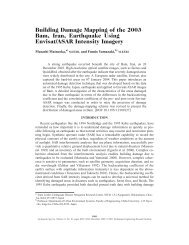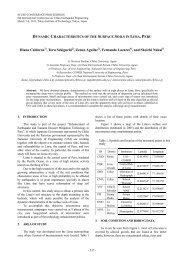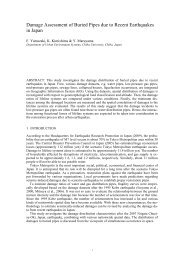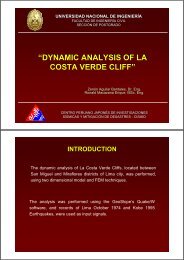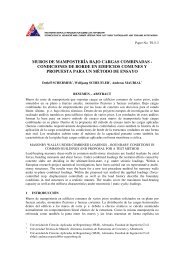Miguel A. Diaz , Koichi Kusunoki , and Akira Tasai
Miguel A. Diaz , Koichi Kusunoki , and Akira Tasai
Miguel A. Diaz , Koichi Kusunoki , and Akira Tasai
You also want an ePaper? Increase the reach of your titles
YUMPU automatically turns print PDFs into web optimized ePapers that Google loves.
mainshock, then neglect the inner shakes, because they do<br />
not produce larger responses than the maximum expected<br />
aftershock.<br />
Using this assumption, the total motion to conduct the<br />
residual seismic performance analysis is given by the<br />
earthquake inputted twice, mainshock <strong>and</strong> aftershock, <strong>and</strong> a<br />
gap between both. The duration of this gap is set in the<br />
measure that the system vibration converges to zero, as<br />
shown in Figure 1.<br />
Eq. (2) is also prescribed by Notification No. 1457-6<br />
(2000), based on the substitute structural method (Shibata<br />
<strong>and</strong> Sozen, 1976). It estimates the equivalent damping ratio<br />
of an equivalent SDOF system as the weighted average<br />
respect to the strain energy with a viscous damping ratio of<br />
0.05 for the first-mode at the damaged-initiation limit state,<br />
since at this stage the building behavior remains elastic.<br />
m W i is the strain energy dissipated in member i.<br />
1.00<br />
0.75<br />
0.50<br />
0.25<br />
0.00<br />
-0.25<br />
-0.50<br />
-0.75<br />
-1.00<br />
1.00<br />
0.75<br />
0.50<br />
0.25<br />
0.00<br />
-0.25<br />
-0.50<br />
-0.75<br />
-1.00<br />
Mainshock<br />
Inner shakes<br />
Gap until system reaches rest<br />
Maximum expected<br />
Aftershock<br />
h eq = ∑<br />
m h eq−i∙ m W i<br />
+ 0.05 (2)<br />
∑ m W i<br />
2.3 Response reduction ratio<br />
The response reduction ratio reduces the elastic spectral<br />
response to the inelastic response. Notification No. 1457-6<br />
(2000) also prescribes the response reduction ratio as Eq. (3),<br />
which guarantees the life-safety limit state.<br />
F h = 1.5<br />
1+10∙h eq<br />
(3)<br />
Figure 1 Aftershock assumption<br />
2.2 Equivalent damping ratio<br />
The equivalent damping ratio for yielding structures<br />
can be determined by the hysteresis damping in terms of the<br />
elastic strain energy of a structure by means of the geometric<br />
stiffness method (Jennings, 1968).<br />
Notification No. 1457-6 (2000) prescribes the<br />
equivalent damping ratio m h eq−i of a structural member i<br />
in Eq. (1) for the life-safety limit state.<br />
h eq−i m<br />
= γ ∙ (1 − 1⁄ √μ) (1)<br />
The coefficient γ in Eq. (1) is assumed as 0.25 in case<br />
of material which constitutes the member, <strong>and</strong> the joint<br />
connected to the adjacent member are rigid; <strong>and</strong> as 0.20 in<br />
cases of members or braced members where the buckling<br />
strength is degraded by the compressive forces when seismic<br />
forces acts (member exhibits a slip-type characteristic), as<br />
prescribed Notification No. 1457-6 (2000).<br />
The coefficient γ in Eq. (1) may hold good for the<br />
estimation of the equivalent damping ratio due to<br />
mainshocks; otherwise the energy dissipation (or equivalent<br />
damping) due to the aftershock is less than or equal to that<br />
due to its corresponding mainshock. Therefore, this<br />
coefficient can be conveniently reduced in order to obtain<br />
larger responses, such as responses during an aftershock,<br />
since the response reduction ratio in Eq. (3) is inversely<br />
proportional to the equivalent damping ratio in Eq. (1). Thus,<br />
the coefficient γ is reduced to 0.12 <strong>and</strong> 0.08 by an<br />
appropriate curve fitting based on a series of nonlinear<br />
simulations obtained for systems under aftershocks (<strong>Diaz</strong> et<br />
al., 2012).<br />
Additionally, previous work by <strong>Diaz</strong> et al. (2012)<br />
proposes a new equation of the response reduction ratio,<br />
given by Eq. (4). It is developed solving the equation of<br />
motion under the stationary vibration, <strong>and</strong> then adapting it to<br />
the non-stationary vibration, such as earthquake motions, by<br />
means of curve fitting to analytical response of a series of<br />
nonlinear simulations.<br />
F h ∗ = √ 1.1+α∙h eq 2<br />
1+(40+α)∙h eq<br />
2 (4)<br />
The Japanese Building St<strong>and</strong>ard Law Enforcement<br />
Order requires that spectral acceleration of a structure at a<br />
limit state should be higher than the corresponding<br />
acceleration of the reduced dem<strong>and</strong> spectrum using the<br />
equivalent damping ratio at the same limit state.<br />
2.4 Seismic performance evaluation<br />
During a damaging earthquake, some buildings may<br />
survive, but the subsequent aftershocks may or may not<br />
cause the building collapse; that’s why, it is desirable to<br />
recognize the building state (seismic performance) after a<br />
mainshock, <strong>and</strong> to estimate the seismic performance due to<br />
the maximum expected aftershock in order to anticipate if<br />
the building may or may not survive, <strong>and</strong> so safeguard life.<br />
The seismic performance of a building due to a given<br />
earthquake motion is examined by comparing the capacity<br />
curve <strong>and</strong> dem<strong>and</strong> spectrum in terms of S a − S d relations,<br />
as shown in Figure 2. The intersection between the capacity<br />
curve <strong>and</strong> the dem<strong>and</strong> spectrum for an appropriate<br />
equivalent damping ratio which represents the inelastic<br />
response under the given earthquake, is called the<br />
performance point (ATC-40, 1996).<br />
- 1204 -





